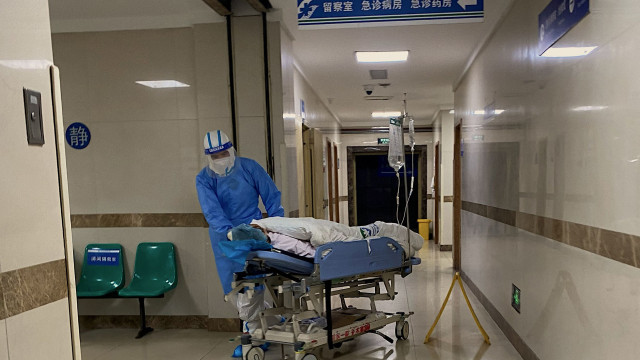




































See Also
See Again
© Shutterstock
0 / 37 Fotos
Integration of AI in health care
- Artificial intelligence (AI) is quickly becoming common in modern health care. In fact, AI's role is already transforming the entire healthcare sector, especially in diagnostics and patient care.
© Shutterstock
1 / 37 Fotos
Integration of AI in health care
- The large amounts of data from clinical trials and patient records AI is capable of analyzing enables doctors to diagnose diseases more accurately and faster than traditional methods.
© Shutterstock
2 / 37 Fotos
Integration of AI in health care
- Consequently, healthcare providers are able to identify which patients might respond better to specific treatments. For example, AI algorithms can analyze imaging data to detect cancers at early stages, thus significantly improving patient outcomes.
© Shutterstock
3 / 37 Fotos
Integration of AI in health care
- AI is also streamlining administrative tasks, thereby reducing the risk of human error and enhancing workflow efficiency. This is helping to improve and advance patient management strategies.
© Shutterstock
4 / 37 Fotos
Hyper-personalized medicine
- The next few years will see the concept of hyper-personalized medicine become more of a reality.
© Shutterstock
5 / 37 Fotos
Hyper-personalized medicine
- This revolutionary approach to medicine involves tailoring medical treatments and procedures to patients based on their genetic and biological makeup, lifestyle, and environment.
© Shutterstock
6 / 37 Fotos
Hyper-personalized medicine
- Hyper-personalized medicine moves beyond a "one-size-fits-all" approach to health care. Instead, it offers more precise and effective treatments, for example identifying genetic predispositions to certain diseases or adverse drug reactions.
© Shutterstock
7 / 37 Fotos
Hyper-personalized medicine
- Technological advancements such as CRISPR (clustered regularly interspaced short palindromic repeats) are at the vanguard of this trend. They provide tools to edit genes directly and remove mutations responsible for genetic disorders.
© Shutterstock
8 / 37 Fotos
Data-driven healthcare transformation
- Data-driven health care is becoming more refined. By harnessing data insights, healthcare professionals can anticipate future trends, enhance patient outcomes, and optimize resource allocation.
© Shutterstock
9 / 37 Fotos
Data-driven healthcare transformation
- Data analytics can significantly improve hospital operations. By analyzing data related to patient flow, bed occupancy rates, and staffing levels, hospitals can identify bottlenecks and streamline processes.
© Shutterstock
10 / 37 Fotos
Data-driven healthcare transformation
- Similarly, by disseminating historical data hospitals can predict patient admission rates, optimize staffing levels, and reduce waiting times.
© Shutterstock
11 / 37 Fotos
Data-driven healthcare transformation
- Harnessed correctly, this strategic data can be a game changer in improving patient care and optimizing operational efficiency.
© Shutterstock
12 / 37 Fotos
Blood testing reimagined
- Blood testing, also called blood work, is a fundamental aspect of diagnostic medicine. It's a common lab test, but often inconvenient and time-consuming.
© Shutterstock
13 / 37 Fotos
Blood testing reimagined
- The methods in which blood work is undertaken are set to change as new healthcare trends emerge. Indeed, patients can expect faster, more accurate tests requiring minimal blood samples, thus making the process less invasive.
© Shutterstock
14 / 37 Fotos
Blood testing reimagined
- The increasing use of microfluidics in medicine enables multiple tests to be made on a singe drop of blood.
© Shutterstock
15 / 37 Fotos
Blood testing reimagined
- This reimagining of blood testing speeds up diagnosis, allowing healthcare professionals to respond more swiftly to patient needs. And the less time spent under the needle, the more comfortable the process is for patients, especially those who require frequent testing.
© Shutterstock
16 / 37 Fotos
Virtual healthcare assistants
- The emergence of virtual healthcare assistants empowers patients to manage their health and well-being through interactive interfaces and personalized health content.
© Shutterstock
17 / 37 Fotos
Virtual healthcare assistants
- These AI-driven platforms provide 24/7 patient support. And they are constantly being updated and refined for greater efficiency.
© Shutterstock
18 / 37 Fotos
Virtual healthcare assistants
- By leveraging modern technology, a virtual healthcare assistant can handle essential tasks remotely in real time. These tools can answer queries, schedule appointments, and remind patients to take medications.
© Shutterstock
19 / 37 Fotos
Virtual healthcare assistants
- While enhancing patient care, virtual assistants streamline communications and reduce administrative burdens for healthcare professionals. This often improves work-life balance for busy doctors and medical consultants.
© Shutterstock
20 / 37 Fotos
The future of telemedicine
- A related application, telemedicine is set to be an increasingly important core component of healthcare delivery.
© Shutterstock
21 / 37 Fotos
The future of telemedicine
- Telemedicine is the use of electronic information and communications technologies to provide and support health care when distance separates the participants.
© Shutterstock
22 / 37 Fotos
The future of telemedicine
- It expands access to specialized one-to-one advice and care as well as providing the flexibility to meet diverse patient needs more efficiently.
© Shutterstock
23 / 37 Fotos
The future of telemedicine
- Telemedicine can also be described as remote patient monitoring. And as information technology advances, so, too, will the ability to chronicle and record health data from patients electronically.
© Shutterstock
24 / 37 Fotos
Wearable technology and IoMT in health care
- Wearable technology used in the medical field to monitor individuals and assist with diagnosis is set to advance.
© Shutterstock
25 / 37 Fotos
Wearable technology and IoMT in health care
- Wearables such as fitness trackers and smartwatches are already collecting real-time data on various health metrics, including heart rate, sleep patterns, and activity levels.
© Shutterstock
26 / 37 Fotos
Wearable technology and IoMT in health care
- Connecting these medical and wearable devices, sensors, and other healthcare-related technology integrated with cloud systems is the Internet of Medical Things (IoMT)—one of the top technological trends of 2025.
© Shutterstock
27 / 37 Fotos
Wearable technology and IoMT in health care
- As these devices become even more sophisticated, providing deeper insights into patient health, the medical industry expects this network of connected devices to continue to grow in the healthcare landscape.
© Shutterstock
28 / 37 Fotos
3D printing
- The advent of 3D printing in medicine and health care has paved the way for the development of a broad range of organ replacements and prosthetics.
© Shutterstock
29 / 37 Fotos
3D printing
- One of the most promising applications is in the creation of customized, patient-specific implants.
© Shutterstock
30 / 37 Fotos
3D printing
- The use of precision 3D printing technology has also allowed for the development of surgical tools and anatomical models, leading to improved surgical planning and patient outcomes.
© Shutterstock
31 / 37 Fotos
3D printing
- For example, 3D-printed organ models allow surgeons to practice complex procedures before performing them on patients.
© Shutterstock
32 / 37 Fotos
Nanotechnology
- Perhaps the most exciting advance in medical technology is the increasing use of nanotechnology in diagnostic testing.
© Getty Images
33 / 37 Fotos
Nanotechnology
- Once the stuff of science fiction, medical nanotechnologies are still relatively new, but the concept of creating devices and machines that are several thousand times smaller than the width of a human hair is a well-established fact.
© Shutterstock
34 / 37 Fotos
Nanotechnology
- Currently, the technology is impacting how clinicians diagnose, treat, and prevent a broad range of diseases.
© Shutterstock
35 / 37 Fotos
Nanotechnology
- Exemplifying this new technology is the “smart” pill, an ingestible electronic device shaped and designed like a pharmaceutical pill but which uses diagnostic sensors to detect disease long before a patient exhibits any symptoms. Sources: (AMN Healthcare) (Forbes) (National Institutes of Health) (The Medical Futurist) (ScienceDirect)
© Shutterstock
36 / 37 Fotos
© Shutterstock
0 / 37 Fotos
Integration of AI in health care
- Artificial intelligence (AI) is quickly becoming common in modern health care. In fact, AI's role is already transforming the entire healthcare sector, especially in diagnostics and patient care.
© Shutterstock
1 / 37 Fotos
Integration of AI in health care
- The large amounts of data from clinical trials and patient records AI is capable of analyzing enables doctors to diagnose diseases more accurately and faster than traditional methods.
© Shutterstock
2 / 37 Fotos
Integration of AI in health care
- Consequently, healthcare providers are able to identify which patients might respond better to specific treatments. For example, AI algorithms can analyze imaging data to detect cancers at early stages, thus significantly improving patient outcomes.
© Shutterstock
3 / 37 Fotos
Integration of AI in health care
- AI is also streamlining administrative tasks, thereby reducing the risk of human error and enhancing workflow efficiency. This is helping to improve and advance patient management strategies.
© Shutterstock
4 / 37 Fotos
Hyper-personalized medicine
- The next few years will see the concept of hyper-personalized medicine become more of a reality.
© Shutterstock
5 / 37 Fotos
Hyper-personalized medicine
- This revolutionary approach to medicine involves tailoring medical treatments and procedures to patients based on their genetic and biological makeup, lifestyle, and environment.
© Shutterstock
6 / 37 Fotos
Hyper-personalized medicine
- Hyper-personalized medicine moves beyond a "one-size-fits-all" approach to health care. Instead, it offers more precise and effective treatments, for example identifying genetic predispositions to certain diseases or adverse drug reactions.
© Shutterstock
7 / 37 Fotos
Hyper-personalized medicine
- Technological advancements such as CRISPR (clustered regularly interspaced short palindromic repeats) are at the vanguard of this trend. They provide tools to edit genes directly and remove mutations responsible for genetic disorders.
© Shutterstock
8 / 37 Fotos
Data-driven healthcare transformation
- Data-driven health care is becoming more refined. By harnessing data insights, healthcare professionals can anticipate future trends, enhance patient outcomes, and optimize resource allocation.
© Shutterstock
9 / 37 Fotos
Data-driven healthcare transformation
- Data analytics can significantly improve hospital operations. By analyzing data related to patient flow, bed occupancy rates, and staffing levels, hospitals can identify bottlenecks and streamline processes.
© Shutterstock
10 / 37 Fotos
Data-driven healthcare transformation
- Similarly, by disseminating historical data hospitals can predict patient admission rates, optimize staffing levels, and reduce waiting times.
© Shutterstock
11 / 37 Fotos
Data-driven healthcare transformation
- Harnessed correctly, this strategic data can be a game changer in improving patient care and optimizing operational efficiency.
© Shutterstock
12 / 37 Fotos
Blood testing reimagined
- Blood testing, also called blood work, is a fundamental aspect of diagnostic medicine. It's a common lab test, but often inconvenient and time-consuming.
© Shutterstock
13 / 37 Fotos
Blood testing reimagined
- The methods in which blood work is undertaken are set to change as new healthcare trends emerge. Indeed, patients can expect faster, more accurate tests requiring minimal blood samples, thus making the process less invasive.
© Shutterstock
14 / 37 Fotos
Blood testing reimagined
- The increasing use of microfluidics in medicine enables multiple tests to be made on a singe drop of blood.
© Shutterstock
15 / 37 Fotos
Blood testing reimagined
- This reimagining of blood testing speeds up diagnosis, allowing healthcare professionals to respond more swiftly to patient needs. And the less time spent under the needle, the more comfortable the process is for patients, especially those who require frequent testing.
© Shutterstock
16 / 37 Fotos
Virtual healthcare assistants
- The emergence of virtual healthcare assistants empowers patients to manage their health and well-being through interactive interfaces and personalized health content.
© Shutterstock
17 / 37 Fotos
Virtual healthcare assistants
- These AI-driven platforms provide 24/7 patient support. And they are constantly being updated and refined for greater efficiency.
© Shutterstock
18 / 37 Fotos
Virtual healthcare assistants
- By leveraging modern technology, a virtual healthcare assistant can handle essential tasks remotely in real time. These tools can answer queries, schedule appointments, and remind patients to take medications.
© Shutterstock
19 / 37 Fotos
Virtual healthcare assistants
- While enhancing patient care, virtual assistants streamline communications and reduce administrative burdens for healthcare professionals. This often improves work-life balance for busy doctors and medical consultants.
© Shutterstock
20 / 37 Fotos
The future of telemedicine
- A related application, telemedicine is set to be an increasingly important core component of healthcare delivery.
© Shutterstock
21 / 37 Fotos
The future of telemedicine
- Telemedicine is the use of electronic information and communications technologies to provide and support health care when distance separates the participants.
© Shutterstock
22 / 37 Fotos
The future of telemedicine
- It expands access to specialized one-to-one advice and care as well as providing the flexibility to meet diverse patient needs more efficiently.
© Shutterstock
23 / 37 Fotos
The future of telemedicine
- Telemedicine can also be described as remote patient monitoring. And as information technology advances, so, too, will the ability to chronicle and record health data from patients electronically.
© Shutterstock
24 / 37 Fotos
Wearable technology and IoMT in health care
- Wearable technology used in the medical field to monitor individuals and assist with diagnosis is set to advance.
© Shutterstock
25 / 37 Fotos
Wearable technology and IoMT in health care
- Wearables such as fitness trackers and smartwatches are already collecting real-time data on various health metrics, including heart rate, sleep patterns, and activity levels.
© Shutterstock
26 / 37 Fotos
Wearable technology and IoMT in health care
- Connecting these medical and wearable devices, sensors, and other healthcare-related technology integrated with cloud systems is the Internet of Medical Things (IoMT)—one of the top technological trends of 2025.
© Shutterstock
27 / 37 Fotos
Wearable technology and IoMT in health care
- As these devices become even more sophisticated, providing deeper insights into patient health, the medical industry expects this network of connected devices to continue to grow in the healthcare landscape.
© Shutterstock
28 / 37 Fotos
3D printing
- The advent of 3D printing in medicine and health care has paved the way for the development of a broad range of organ replacements and prosthetics.
© Shutterstock
29 / 37 Fotos
3D printing
- One of the most promising applications is in the creation of customized, patient-specific implants.
© Shutterstock
30 / 37 Fotos
3D printing
- The use of precision 3D printing technology has also allowed for the development of surgical tools and anatomical models, leading to improved surgical planning and patient outcomes.
© Shutterstock
31 / 37 Fotos
3D printing
- For example, 3D-printed organ models allow surgeons to practice complex procedures before performing them on patients.
© Shutterstock
32 / 37 Fotos
Nanotechnology
- Perhaps the most exciting advance in medical technology is the increasing use of nanotechnology in diagnostic testing.
© Getty Images
33 / 37 Fotos
Nanotechnology
- Once the stuff of science fiction, medical nanotechnologies are still relatively new, but the concept of creating devices and machines that are several thousand times smaller than the width of a human hair is a well-established fact.
© Shutterstock
34 / 37 Fotos
Nanotechnology
- Currently, the technology is impacting how clinicians diagnose, treat, and prevent a broad range of diseases.
© Shutterstock
35 / 37 Fotos
Nanotechnology
- Exemplifying this new technology is the “smart” pill, an ingestible electronic device shaped and designed like a pharmaceutical pill but which uses diagnostic sensors to detect disease long before a patient exhibits any symptoms. Sources: (AMN Healthcare) (Forbes) (National Institutes of Health) (The Medical Futurist) (ScienceDirect)
© Shutterstock
36 / 37 Fotos
What is the next big thing in medical technology?
How tech is driving health care
© Shutterstock
The first quarter of the 21st century has seen huge advances made in health care and medicine. It's also thrust the medical sector into an advancing technological age. And staying ahead of tech innovation is vital for professionals dedicated to providing top-notch care. But how exactly is emerging technology helping patients and healthcare providers, and what are the future trends set to revolutionize the medical field?
Click through this gallery for a fascinating prognosis.
RECOMMENDED FOR YOU






























MOST READ
- Last Hour
- Last Day
- Last Week








